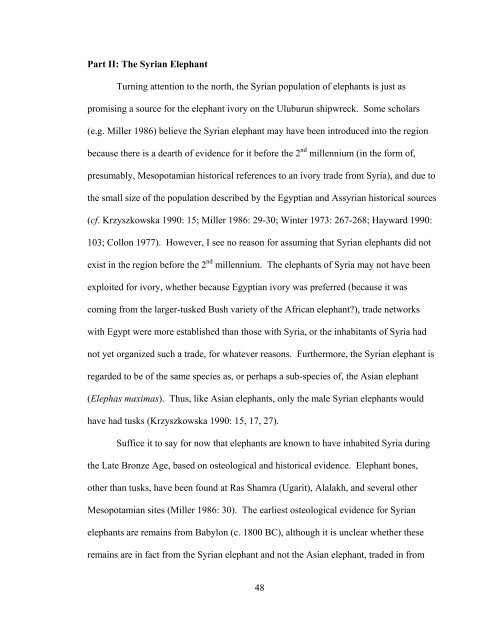Tracing the Source of the Elephant And Hippopotamus Ivory from ...
Tracing the Source of the Elephant And Hippopotamus Ivory from ...
Tracing the Source of the Elephant And Hippopotamus Ivory from ...
You also want an ePaper? Increase the reach of your titles
YUMPU automatically turns print PDFs into web optimized ePapers that Google loves.
Part II: The Syrian <strong>Elephant</strong><br />
Turning attention to <strong>the</strong> north, <strong>the</strong> Syrian population <strong>of</strong> elephants is just as<br />
promising a source for <strong>the</strong> elephant ivory on <strong>the</strong> Uluburun shipwreck. Some scholars<br />
(e.g. Miller 1986) believe <strong>the</strong> Syrian elephant may have been introduced into <strong>the</strong> region<br />
because <strong>the</strong>re is a dearth <strong>of</strong> evidence for it before <strong>the</strong> 2 nd millennium (in <strong>the</strong> form <strong>of</strong>,<br />
presumably, Mesopotamian historical references to an ivory trade <strong>from</strong> Syria), and due to<br />
<strong>the</strong> small size <strong>of</strong> <strong>the</strong> population described by <strong>the</strong> Egyptian and Assyrian historical sources<br />
(cf. Krzyszkowska 1990: 15; Miller 1986: 29-30; Winter 1973: 267-268; Hayward 1990:<br />
103; Collon 1977). However, I see no reason for assuming that Syrian elephants did not<br />
exist in <strong>the</strong> region before <strong>the</strong> 2 nd millennium. The elephants <strong>of</strong> Syria may not have been<br />
exploited for ivory, whe<strong>the</strong>r because Egyptian ivory was preferred (because it was<br />
coming <strong>from</strong> <strong>the</strong> larger-tusked Bush variety <strong>of</strong> <strong>the</strong> African elephant?), trade networks<br />
with Egypt were more established than those with Syria, or <strong>the</strong> inhabitants <strong>of</strong> Syria had<br />
not yet organized such a trade, for whatever reasons. Fur<strong>the</strong>rmore, <strong>the</strong> Syrian elephant is<br />
regarded to be <strong>of</strong> <strong>the</strong> same species as, or perhaps a sub-species <strong>of</strong>, <strong>the</strong> Asian elephant<br />
(Elephas maximas). Thus, like Asian elephants, only <strong>the</strong> male Syrian elephants would<br />
have had tusks (Krzyszkowska 1990: 15, 17, 27).<br />
Suffice it to say for now that elephants are known to have inhabited Syria during<br />
<strong>the</strong> Late Bronze Age, based on osteological and historical evidence. <strong>Elephant</strong> bones,<br />
o<strong>the</strong>r than tusks, have been found at Ras Shamra (Ugarit), Alalakh, and several o<strong>the</strong>r<br />
Mesopotamian sites (Miller 1986: 30). The earliest osteological evidence for Syrian<br />
elephants are remains <strong>from</strong> Babylon (c. 1800 BC), although it is unclear whe<strong>the</strong>r <strong>the</strong>se<br />
remains are in fact <strong>from</strong> <strong>the</strong> Syrian elephant and not <strong>the</strong> Asian elephant, traded in <strong>from</strong><br />
48

















